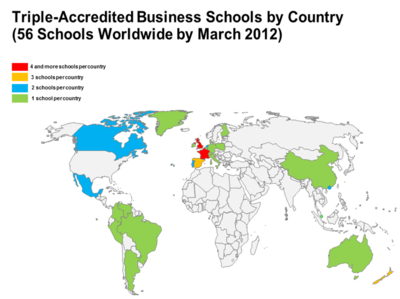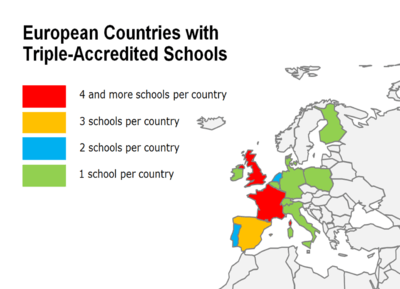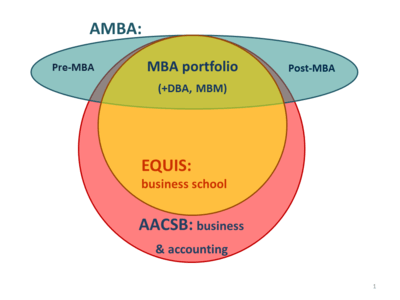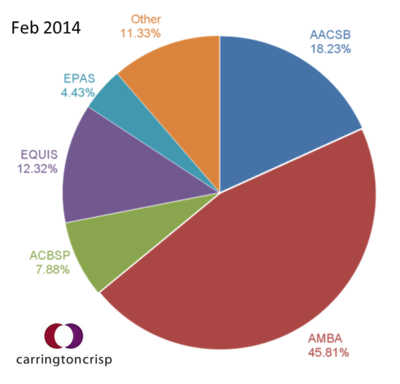Triple accreditation
Triple accreditation is the accreditation awarded to 67 business schools worldwide[1] by the three largest and most influential business school accreditation associations:
- AACSB - The Association to Advance Collegiate Schools of Business (based in Tampa, Florida, with an Asia office in Singapore)


- AMBA - The Association of MBAs (based in London)
- EQUIS - European Quality Improvement System (based in Brussels)
_accreditation_outside_North_America.png)
Of the 13,670 schools offering business degree programs worldwide,[2] only 67 have triple accreditation as of December 2014. The diagram on the right shows the 55 triple-accredited schools outside of North America as of March 2012. Two triple-accredited schools are based in Canada and a further in Sheffield, UK not included in this diagram, bringing the worldwide total to 58. Recently Bradford University School of Management, UK has been added to this list.[E.g. for AACSB, the diagram interpretation is as follows: 53 schools are accredited only by AACSB; a further 7 are accredited by AACSB and AMBA; another 23 are accredited by AACSB and EQUIS; and 55 are accredited by all three accrediting bodies.]
A major reason for the small number of triple-accredited institutions in the world is the requirement of the Association of MBAs that AMBA-accredited business schools should only admit MBA applicants with at least three years of full-time post-graduation work experience.[3] Some analysts claim that most top US business schools cannot meet this criterion as they sometimes (though rarely) admit applicants with only a bachelor's degree and little or no work experience. They claim that it is why triple-crown accreditation is pursued primarily by European institutions.[4] However, it is not the case when some (former) triple accredited institutes, City University of Hong Kong for example, only require applicants having "relevant work experience is desirable (though not specifically required)".[5]
Differences in accreditation
Each of the three institutions assesses a business school according to different criteria and scope:[6][7][8]

- Scope of accreditation
- AACSB has the broadest scope, as it accredits management and accounting programs at the entire university (e.g. management programs at the business school and the school of engineering) and grants university-wide accreditation.
- AMBA has the most focused scope as it accredits only the business school's portfolios of MBA programs (full-time, part-time, executive, distance-learning), MBM programs (including MSc International Management) and DBA (also known as DMgt in China).
- EQUIS's scope ranks in the middle, as it accredits the business school but not the university and not specific portfolios of programs.
- Duration of the accreditation process
- AACSB: 2–7 years
- AMBA: 9–18 months
- EQUIS: 2–3 years
- Reaccreditation
- AACSB: full re-accreditation every 5 or 10 years (the 10-year accreditation is being phased out)
- AMBA: full re-accreditation every 3 or 5 years (1-year accreditation is a possible outcome of reaccreditation in exceptional circumstances)
- EQUIS: full re-accreditation every 3 or 5 years
- School audit team
- AACSB's peer review team includes deans and business school administrators.
- AMBA's assessment team includes deans, associate deans, program directors and one AMBA representative.
- EQUIS's team includes only deans.
- Evaluation report content
- AACSB's report reflects compliance with the AACSB standards
- AMBA's report includes compliance with criteria, commendations and recommendations
- EQUIS's report reflects compliance with the EQUIS standards
- Criteria/Standards size
- AACSB: 77 pages for Business Accreditation; 36 pages for Accounting Accreditation
- AMBA: 24 pages (9 pages for MBA; 9 pages for MBM; 6 pages for DBA)
- EQUIS: 67 pages
- Quantitative vs Qualitative
- AACSB has more quantitative criteria (checklists)
- AMBA has more qualitative criteria
- EQUIS is in the middle (between AACSB and AMBA)
- Internationalization
- AACSB conducts the evaluation against the school's own mission, so AACSB has no internationalization requirement unless internationalization is part of the school's mission.
- AMBA has internationalization criteria for research, curriculum and student enrolment. However, these are reviewed in a regional context for less internationalized regions (e.g. Latin America and Russia).
- EQUIS has strict requirements on internationalization.
- Faculty numbers
- AACSB: prescribed faculty ratios (AQ/PQ ratio)
- AMBA: no prescribed faculty-to-students ratio
- EQUIS: prescribed minimum numbers of faculty

- Visiting faculty
- AACSB disapproves of heavy use of visiting faculty.
- AMBA allows the visiting faculty model, as long as the visiting faculty are managed by the core faculty (and as long as the quality and course content is monitored).
- EQUIS disapproves of heavy use of visiting faculty.
- Research
- AACSB requires research in line with the mission of the school.
- AMBA requires research and publications in international refereed journals or proof of impactful research at national level.
- EQUIS requires research with an international dimension.
- Program-specific criteria
- AACSB has no program-specific standards since it evaluates the entire university.
- AMBA has program-specific criteria such as:
- at least 3 years of full-time work experience for all admitted MBA students;
- at least 500 contact hours (scheduled class hours) for a full-time MBA curriculum and a minimum of 120 contact hours for a distance-learning MBA;
- at least 20 students enrolled in an MBA program;
- EQUIS has no program-specific standards since it evaluates the entire business school.
- Accreditation fees
- AACSB: 17,500 USD for initial business accreditation (or 26,800 USD for both business and accounting accreditation). In addition, an annual business accreditation fee is charged: 4,500 USD annually for a 5-year accreditation cycle or 2,500 USD annually for a 10-year accreditation cycle.[9]
- AMBA: 22,000 GBP for initial accreditation or 15,000 GBP for re-accreditation.
- EQUIS: 38,675 EUR for a 5-year initial accreditation or re-accreditation and 32,725 EUR for a 3-year initial accreditation or re-accreditation.[10]
Schools
There are 66 triple-accredited schools based in 26 countries and territories as of November 2012:[11][12][13]
Argentina
- IAE Universidad Austral, Buenos Aires
Australia
- QUT Graduate School of Business, Queensland University of Technology
- Monash University
Belgium
Brazil
- EAESP - Fundação Getúlio Vargas, São Paulo
Canada
- HEC Montreal, Montreal
- Telfer School of Management, University of Ottawa, Ottawa
China
- Antai College of Economics and Management, Shanghai Jiao Tong University, Shanghai
- Faculty of Business, The Hong Kong Polytechnic University, Hong Kong
- School of Business, The Hong Kong Baptist University, Hong Kong
- Sun Yat-sen Business School, Sun Yat-sen University
- Lingnan (University) College, Sun Yat-sen University
Colombia
- Universidad de los Andes, Facultad de Administración, Bogota
Denmark
- Copenhagen Business School, Copenhagen
- Aarhus BSS, Aarhus[14]
Egypt
- The American University in Cairo, Cairo
Finland
- Aalto University School of Business, Helsinki
France
- Audencia Nantes, Nantes
- KEDGE Business School – Created by BEM & Euromed Management
- EDHEC (École des hautes études commerciales du nord), Lille & Nice
- EMLYON Business School, Lyon
- ESCP-Europe (École supérieure de commerce de Paris — Europe), Paris
- Grenoble School of Management, Grenoble
- HEC Paris (Ecole des Hautes Etudes Commerciales), Paris
- INSEAD (Institut Européen d'Administration des Affaires), Fontainebleau & Singapore
- NEOMA Business School – Created by Reims Management School & Rouen Business School
- Toulouse Business School, Toulouse
- ESC Rennes School of Business, Rennes
- [(ESC PAU School of Management and Business School, Pau
Germany
- ESCP Europe, Berlin
- Mannheim Business School, Mannheim
Ireland
- University College Dublin, Michael Smurfit Graduate School of Business/UCD Quinn School of Business, Dublin
Italy
- ESCP Europe, Turin
- SDA Bocconi School of Management, Milan
Mexico
- EGADE Business School, Tecnológico de Monterrey, Monterrey and Mexico City.
- Instituto Tecnológico Autónomo de México, Mexico City.
The Netherlands
- Maastricht University, School of Business and Economics, Maastricht
- Rotterdam School of Management, Erasmus University Rotterdam, Rotterdam
New Zealand
- University of Auckland Business School, Auckland
- University of Waikato Faculty of Management, Hamilton
- Victoria University of Wellington, Victoria Business School, Wellington
Norway
Peru
- CENTRUM Católica, Pontificia Universidad Católica del Perú, Lima
Poland
- Kozminski University, Warsaw
Portugal
- CATÓLICA-LISBON, School of Business & Economics, Lisbon
- Nova School of Business and Economics, Lisbon
South Africa
- University of Cape Town Graduate School of Business, Cape Town
- University of Stellenbosch Business School, Cape Town
Spain
- ESADE Business School and ESADE University Faculties, Barcelona
- ESCP Europe, Madrid
- IE Business School, Madrid
- IESE Barcelona
Switzerland
- IMD Lausanne
UK
- Ashridge Business School, Berkhamsted
- Aston Business School, Aston University, Birmingham
- University of Birmingham, Birmingham
- Bradford University School of Management, University of Bradford, Bradford
- Cass Business School, City University London, London
- Cranfield School of Management, Cranfield University, Bedfordshire
- Durham University Business School, Durham University, Durham
- University of Edinburgh Business School, Edinburgh University, Edinburgh
- ESCP Europe, London
- Henley Business School, University of Reading, Henley-on-Thames and Reading
- Imperial College Business School, London
- Lancaster University Management School, Lancaster University, Lancaster
- Leeds University Business School, University of Leeds, Leeds
- London Business School, London
- Loughborough University School of Business and Economics, Loughborough University, Loughborough
- Manchester Business School, University of Manchester, Manchester
- Newcastle University Business School, Newcastle University, Newcastle upon Tyne
- Open University Business School
- University of Sheffield Management School, University of Sheffield, Sheffield
- Strathclyde Business School, University of Strathclyde, Glasgow
- Warwick Business School, University of Warwick
Venezuela
- IESA, Caracas
Top schools without triple accreditation
Many of the world's top business schools are not triple-accredited, while several schools that appear low in the rankings have triple accreditation.
One reason for this is that some of the top business schools choose not to incur the financial cost of international accreditation and rely only on accreditation by their national accrediting body (usually the country's education ministry).
Another reason is that the top schools in some regions do not meet one or more of the detailed criteria of the accrediting institutions and choose not to amend their policy. Notable examples are all top US business schools: Harvard Business School, Wharton, Stanford GSB, Columbia Business School, Chicago Booth, etc., which do not meet AMBA's mandatory three-year student-work-experience requirement for all MBA applicants.
A third reason is that the 509 schools that have obtained AACSB accreditation in the US and Canada (either via the standard accreditation process or via the granting of accreditation based on their reputation as top schools) do not look outside of North America for further validation, such as through European or British accreditation.
See also
References
- ↑ "Triple accredited business schools (AACSB, AMBA, EQUIS)". MBA Today.
- ↑ The Economist. Oct 15th 2011. "Is time running out for business schools that aren’t quite elite?"
- ↑ AMBA Criterion 5.4, P. 5 - http://www.mbaworld.com/administrator/file_sys/uploaded_files/1299681060-MBA%20critieria_web.pdf
- ↑ "Andreas Kaplan: European Management and European Business Schools: Insights from the History of Business Schools, European Management Journal, 2014".
- ↑ "MBA Admissions Requirements, City University of Hong Kong".
- ↑ AACSB Standards http://www.aacsb.edu/accreditation/standards.asp
- ↑ AMBA Criteria http://www.mbaworld.com/accreditationcriteria
- ↑ EQUIS Standards and Criteria http://www.efmd.org/accreditation-main/equis/equis-guides
- ↑ http://www.aacsb.edu/accreditation/fees.asp
- ↑ http://www.efmd.org/index.php/accreditation-main/equis/equis-fee-structure
- ↑ AMBA-accredited schools: http://www.ambaguide.com/find-an-accredited-programme/schools/
- ↑ AACSB-accredited schools: http://www.aacsb.edu/accreditation/accreditedmembers.asp
- ↑ EQUIS-accredited schools: http://www.efmd.org/accreditation-main/equis/accredited-schools
- ↑ http://bss.au.dk/currently/news/news-item/artikel/amba-accreditation-for-school-of-business-and-social-sciences/